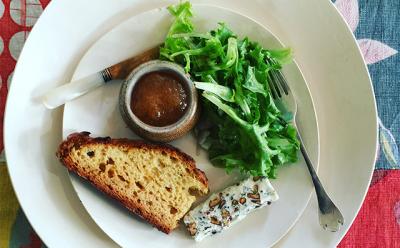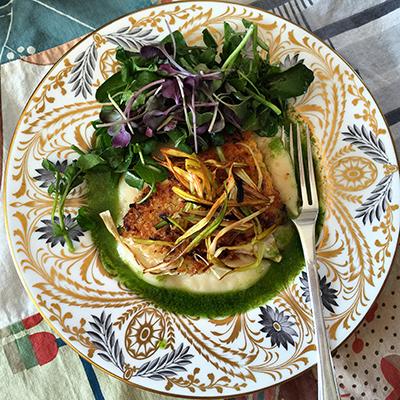Recipes 04.07.16
Recipes 04.07.16
Almond’s Brussels Sprouts
Two Ways in the Style of Caesar Salad
Serves four.
For the dressing:
1 Tbsp. anchovy paste
2 small garlic cloves
2 large egg yolks
3 Tbsp. finely grated Parmesan
2 Tbsp. fresh lemon juice
2 dashes Worcestershire sauce
1 Tbsp. rinsed capers
1 dash Tabasco
3/4 tsp. Dijon mustard
An ice cube or two
3 Tbsp. olive oil, divided
1/2 cup vegetable oil
Freshly ground black pepper and kosher salt to taste
In a blender, puree all the ingredients except for the oils, salt, and pepper. Now, with the blender running add the oils in a thin constant stream. Season with salt and pepper.
For the croutons:
1 cup diced bread
2 Tbsp. olive oil
1 sprig rosemary
2 smashed garlic cloves
In a sauté pan gently heat the olive oil with the garlic and the rosemary. Add the bread and toast until golden brown.
Salad:
1 lb. brussels sprouts (half sliced thinly with a mandoline; half quartered)
1 lemon cut into wedges
4 white Spanish anchovies (boquerones)
1 small piece of Pecorino Toscano cheese (for shaving)
1 quart canola oil (for frying)
Salt and black pepper to taste
In a deep and wide saucepot, preheat the canola oil to 350 degrees.
In a mixing bowl toss the shaved brussels sprouts with the croutons, a desired amount of dressing (you’ll probably end up with extra), salt, and pepper.
Arrange the salad on a platter and garnish with a couple of the lemon wedges and the anchovies.
Right before you are about to serve, carefully drop the quartered sprouts into the canola oil. Fry for 30 seconds and toss with a couple squirts of lemon and a bit of salt.
Cascade the fried sprouts over the salad.
Shave some cheese on top and serve.




